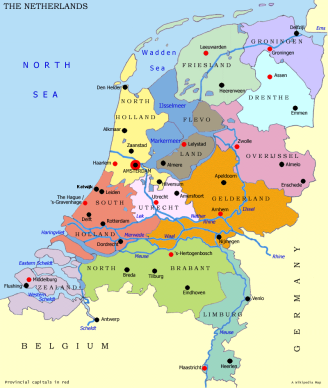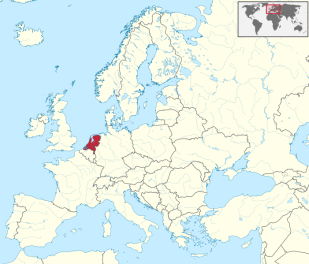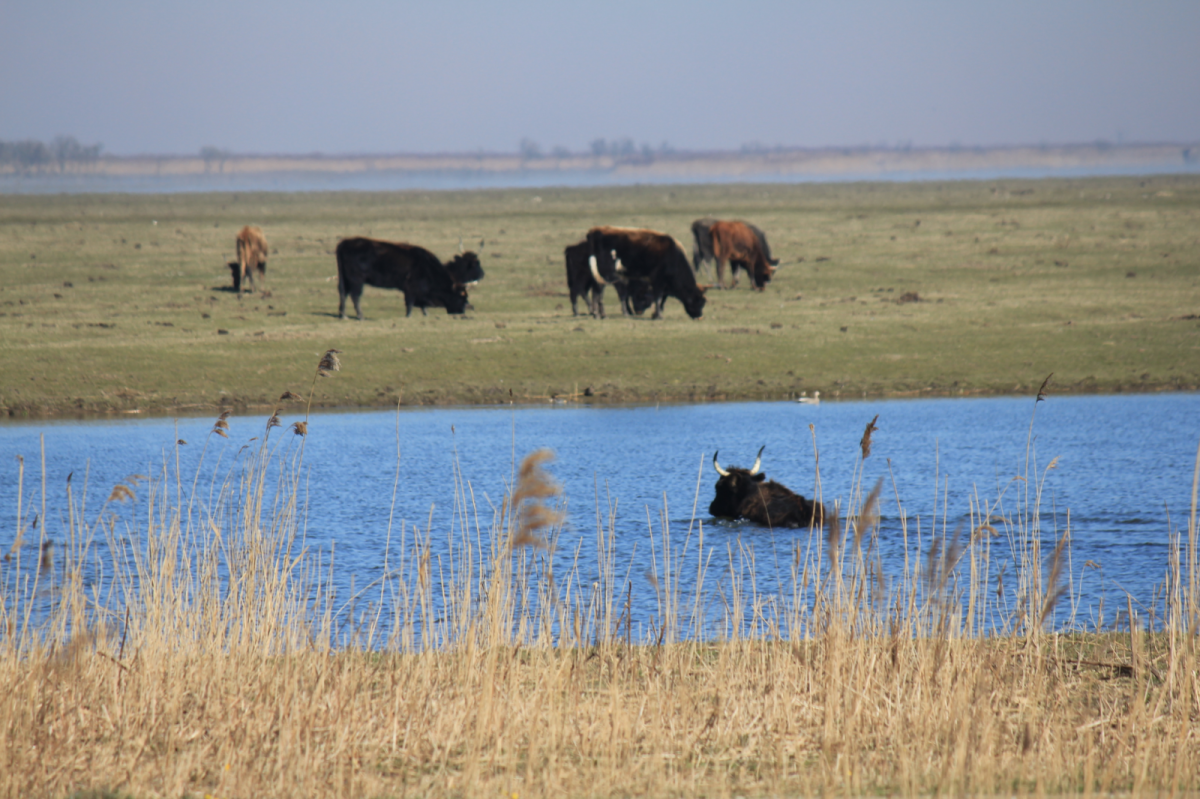Besides being a name no English-native person would attempt to pronounce, Oostvaardersplassen is a nature reserve in the Netherlands. It is unlike most nature reserves, because well, there is nothing being preserved or reserved. This is because naturally nothing belongs on this land, the land belongs below the sea-level. With the geography of the area changing and some help from a human engineered dam this 15,000 acre park emerged from the depths of the sea.
Where is Oostvaardersplassen?


^ The map on the right highlights Netherlands location in Europe and the map on the left the regions of Netherlands. The brown region named “Flevo” is where Oostvaardersplassen is located.
The Paleolithic Ecosystem
Since this land was underwater, it was uninhabited (by land critters at least). But, this entire Northeast region of Europe was a habitat and was home to a great deal of biodiversity. The southern European countries are very mountainous, but this little sliver including Netherlands is right on the edge of Europe’s northern plains. This region provided the land for some now extinct species such as: aurochs, tarpan (wild horse), wisent (bison), and red deer (elk).
While there are many people responsible for the how Oostvaarderplassen has been reclaimed, including the people of the region and the government, an ecologist named Frans Vera is primarily responsible. At the time of the parks origins in the 1970’s, it was widely believed that nature needs constant attention and laboring, Vera disagreed and said when nature has it’s proper ingredients it can run its course systematically.
So, he drove onto this marshy land with trucks filled of Heck cattle and started to populate the land. The Heck cattle are not native to this region, in fact they are not native to any land, they were genetically engineered by Nazi scientists. (ok, that statement probably raises some questions, which are hopefully answered here.) These Heck cattle act as the extinct aurochs. Aurochs were believed to be very good browsers of very wetland, which is unusual in most of todays cattle and great considering this land is very marshy, being that it literally just came out of the sea.
Then Vera brought some Konik horses, 40 of them. These horses would assume the roles of the wild tarpan that once roamed this region in paleolithic times. Red deer were bought in to take over their old niche. Soon, wild animals seemed to have been finding out about the land and migrating on over-foxes, muskrats, herons, eagles, and other large birds of prey were swooping in on the benefits of the preserve.
Missing Components to the Park
Much like how all of the wolves were extirpated from Yellowstone, wolves have been extirpated from most of Europe for many generations. This is also a major problem for Oostvaardersplassen, there are no predators. 15,000 acres is a whole lot of land, but not when there are no limiting factors keeping the numbers of herbivores in check. 15,000 acres of resources could go fast and animals face the risk of starvation. Yes, it is a natural thing for populations to be in competition with each other and resources will always be limited. However, without predators the competition becomes severe and out of control. So, park officials actually shoot the weak herbivores in the winter months, which estimates to be up to 60% of all the deaths in the park. This raises ethical questions, but also is an inefficient way of advancing an ecologically sustainable park. This is why Vera is an advocate of introducing wolves to the park, something he calls “the way of the future.”
Back from Extinction
Here at De-Extinction Dot Net we talk about species that have gone extinct and could be brought back. Well, obviously it is best if the species never goes extinct in the first place. The white-tailed eagle, native to Eurasia (the combined super-continent of Europe and Asia) was severely facing extinction. Fear or losing the majestic bird of prey, a lot of legislation was past to preserve the species. This was not the only thing that helped save the species, Oostvaardersplassen has become a sanctuary for the raptor. It was unintentional; Oostvaardersplassen lacks tall trees, which is where researches believed the eagles would only nest. The birds started to come in and they found alternative nesting solutions, compromising a comfy well-known shelter for the ability to have a sustainable habitat. Europeans for years have been doing their own breeding and rewilding programs for the bird, Oostvaardersplassen was able to do this and it was not even attempting to. Thus, proving that nature’s engineering is sufficient without human intervention. It should be noted that there was a ton of success in these rewilding programs and these types of conservation methods are very well needed and helpful.
De-Extinction Works.
All of these contributions and Oostvaardersplassen park has now brought the White-tailed Eagle from the “Critically Endangered” side all the way to “Least Concerned.” It may not have been de-extinction in the classical sense that the species was lost and brought back; but essentially this species was just as good as gone and since has been brought all the way back. This ecosystem is not even at 100% functionality yet and it is making great strides at preserving species. If a species that have gone extinct can be reintroduced, even in low numbers, would they be able to survive similarly and make a comeback just like the White-tailed Eagle?
The question is if a species is introduced in the proper environment with the necessary components, why would the species not make a comeback…?
